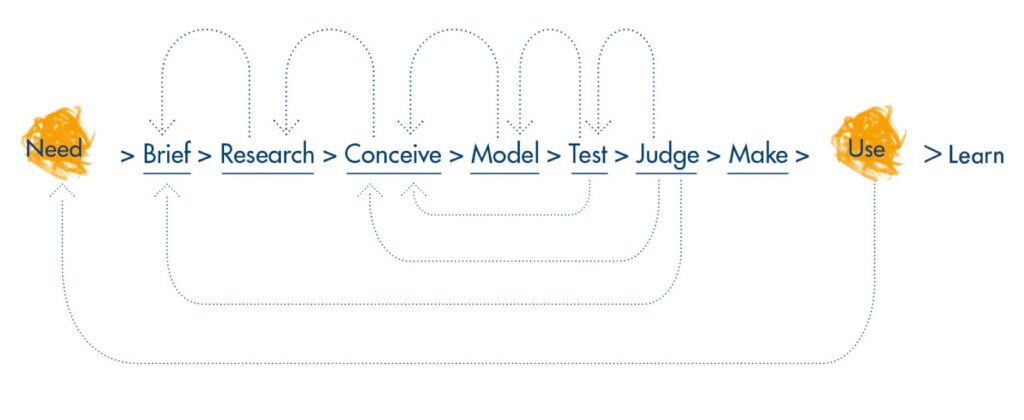Design can be many things. It can be a noun, as in ‘I like good design’, or, ‘I don’t think the design is very good’. It can be an adjective, as in ‘designer sunglasses’. And it can be a verb, as in ‘we are designing a new concert hall’.
It is its use a verb that I address primarily in my teaching. By thinking of design as something that we do, rather than something that is created, we can work on doing the designing better.
If we focus on design as something that we do, then the next question we can ask is what does the process of doing design actually involve, and what frame of mind do we need for each stage.
In this entry we explore two models for describing design as a process. These models are the genesis for continuous, place-based design, an approach to design that is more compatible with the goals of regenerative design.
Chevron diagram
This is the model that I use when I first talk to people about design. When I think of design as a process, I think of my hands held up in front of me like two opposing chevrons. These chevrons conjure up for me four distinct phases in the design process. The four phases are:
- Starting – listening to others
- Divergent thinking – having ideas
- Convergent thinking – improving ideas
- Selling – convincing others
In my mind I see the process as something that looks like two opposing chevrons, like this <>
Something starts from very little, blows up into many possibilities and then shrinks back down to a final, well-resolved output.
Each of these phases of operation requires a different mode of thinking. Each of these modes of thinking is something that we can teach.
Think Up Design Process Diagram
My model is very simple, and is in fact a simplified version of the Think Up Design Process Diagram.

Based on a work at https://thinkup.org/describing-design-as-a-process/
In this model, design is as the heart of a project process that starts with the identification of some sort of need and leads to something that is used. Here is an overview of each of the stages, each of which can afford longer exploration.
Need – the process begins with identifying some sort of need. That need can be felt by a client, a group of people, an ecosystem.
Brief – the stage at which the brief for the design work is defined. It is against the brief that we will test our ideas. But the brief can never be fully known because of the designer’s paradox and system complexity. We will have much more to say on this.
Research – the stage in which we gather together all the creative inputs to the idea conception phase. (See filling the Kalideascope – creative inputs in the moment).
Conceive – the stage at which we develop our ideas in response the brief and drawing on inputs from our research. In reality our we are usually having ideas right the way through the design process, but it is valuable to identify it as a distinct stage in order to give it attention, to make time for it, and to invest in having better ideas. (See what is an idea and the Kalideascope model for idea generation).
Model – the stage at which we turn our ideas into something we can communicate and test. This is another often-forgotten about stage in the design process. An idea is a pattern in the brain that happens when our neurones fire. To test our ideas we need a way to get them out of our head into some sort of thing – a model – that we can test.
Test – the stage at which we test our ideas, in the form of models, against the brief. This relationship between the brief, the tests we create and the models we use to carry them out is important to understand in order to have a rigorous design process.
Judge – the stage at which we descide on the basis of all the tests if the idea is adequate. An idea may have passed all the tests and still not be adequate. In which you need to go back to your brief to try to understand what is unsaid that needs to be said in order to develop a better design.
Make – the stage at which we start to build the design. This distinction of modelling and making is particularly relevant in the built environment where our modelling might involve simulations, but the making involves large volumes of construction materials. In other areas of design in which it is possible to work on live, usable versions of the design, then there is little distinction between the make model and make stages.
Use – the stage at which what we have design enters into use.
Learn – the stage at which we learn from the design in use. In manufacturing industries, there tends to be a tight feedback loop between use and design. We call it quality control. In construction there is usually a very poor feedback loop between use of the design and the design of the next project.
There are feedback loops at every stage of the process. Developing an idea can lead to new insights about the brief. Writing the brief can cause us to challenge the brief. When we come to judge the final design, we may have cause to come back and change brief.
